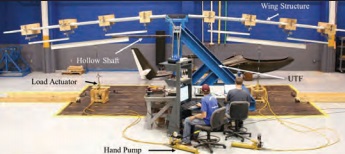Chapter: Fiber Optic Sensing, new invention technology, Research project papers,
Determining Applied Load Data with Strain Measurements

Determining Applied Load Data with
Strain Measurements
Armstrong researchers have developed a method for obtaining
externally applied, out-of-plane operational load data on complex structures
using surface in-plane strain measurements. This approach allows for efficient
characterization of out-of-plane bending and torsional stiffness of structures.
Currently, industry
uses computational methods such as finite element analysis (FEA) to obtain
operational load data for complex structures; however, this approach is time
consuming and requires the structure to be broken down into small elements for
analysis, a challenging task for structures with complex geometries. To obtain
real-time load data,
standard methods rely on the use of strain gauges on the
structure, yet a costly and extensive calibration process must be performed
prior to real-time analysis. This Armstrong-developed method saves time and is
more efficient and accurate.
Benefits
Provides real-time data: Enables measurements
outside test facilities and during operation
Less expensive: Provides similar
spatial resolution to that obtained from the more cumbersome,
labor-intensive, and costly FEAs
More
accurate: Improves accuracy of the simplified structural models
Applications
Aircraft wing analysis
Structural health monitoring for
buildings, bridges, and ships
Fiber Optic Sensing
Armstrong's portfolio of Fiber Optic Sensing System (FOSS)
technologies offers unparalleled options for high-resolution sensing in
applications that require a unique combination of high-powered processing and
lightweight, flexible, and robust sensors. The system measures real-time
strain, which can be used to determine two-dimensional and three-dimensional
shape, temperature, liquid level, pressure, and loads, alone or in combination.
Initially developed to monitor aircraft structures in flight, the system's
capabilities open up myriad new applications for fiber optics-not just in
aerospace but also for civil structures, transportation, oil and gas, medical,
and many more industries.
The Armstrong approach employs fiber Bragg grating (FBG)
sensors, optical frequency domain reflectometry (OFDR) sensing, and
ultra-efficient algo-rithms (100 samples/second). Engineers are continually
seeking new ways of looking at information and determining what is important.
Armstrong's FOSS technologies focus on critical research needs. Whether it is
used to determine shape, stress, temperature, pressure, strength, operational
load, or liquid level, this technology offers ultra-fast, reliable
measurements.
Related Topics